#nanshan
Text
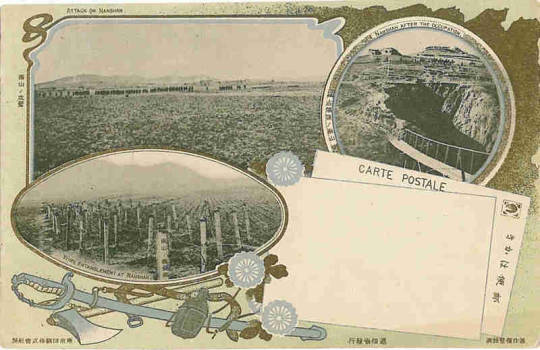


Commemorative postcard - Russo-Japanese war 1904 - NANSHAN.
0 notes
Text

Shenzhen Bay Highway Bridge, Shenzhen Bay Park, Nanshan, Shenzhen, Guangdong Province, China
Taken by Cai Fang
#Shenzhen Bay Highway Bridge#Shenzhen Bay Park#Nanshan#Shenzhen#Guangdong Province#China#Asia#Bridge
0 notes
Photo
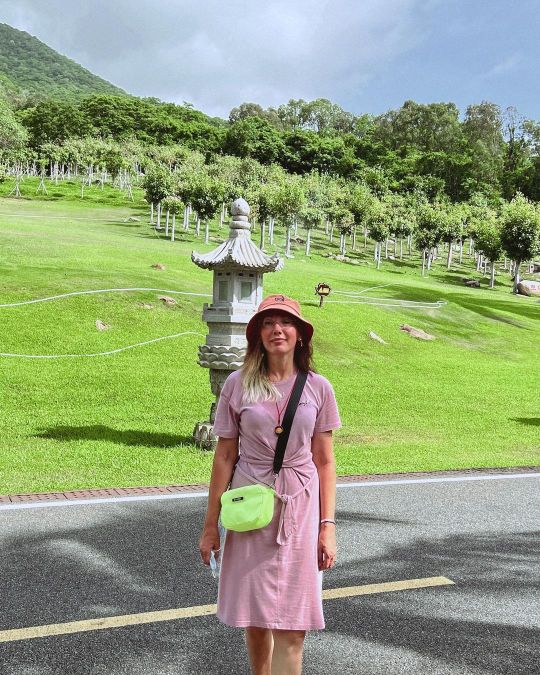
Miracle Dear 2022.06.13 💙 #karus_china . . . #sanya2023 #sanya2022 #hainan #sanya_online #aesthetic #artofinstagram #abstractart #aesthetic #nanshantemple #nanshan #darkaesthetic #darkacademia #darkaesthetic #nature #dior #buddha #china #ekdme #architecture #karus_china (at Nanshan Guanyin Buddha) https://www.instagram.com/p/CevozQGr6lr/?igshid=NGJjMDIxMWI=
#karus_china#sanya2023#sanya2022#hainan#sanya_online#aesthetic#artofinstagram#abstractart#aesthetic#nanshantemple#nanshan#darkaesthetic#darkacademia#darkaesthetic#nature#dior#buddha#china#ekdme#architecture
0 notes
Text

2,200-Year-Old Bronze Artifacts Uearthed in China
While exploring an ancient site in China, a team of archaeologists recently stumbled upon an abundant trove of ancient bronze objects dating back at least 2,200 years. Among their finds were plates, tripods, decorative ornaments — and a collection of swords.
Experts were exploring one of three sprawling sites in Shaoxing, officials from the Zhejiang Provincial Institute of Cultural Relics and Archaeology said, according to a Feb. 7 post from the Chinese Academy of Social Sciences. The three sites are known as Tingshan, Nanshantou and Nanshan.
The sites — and the ruins and artifacts found during excavations — date to China’s Spring and Autumn Period and the Warring States era, which lasted from 770 B.C. until about 221 B.C.
Archaeologists also found the ruins of a large building and other ancient remains while exploring the three sites. Here’s what they discovered.
SWORDS AND OTHER BRONZE ARTIFACTS
The seven swords and bronze artifacts were unearthed at the Nanshan site, officials said.
Of the seven swords, only three were completely preserved. Two fragments from the weapons had characters engraved on them, according to archaeologists.

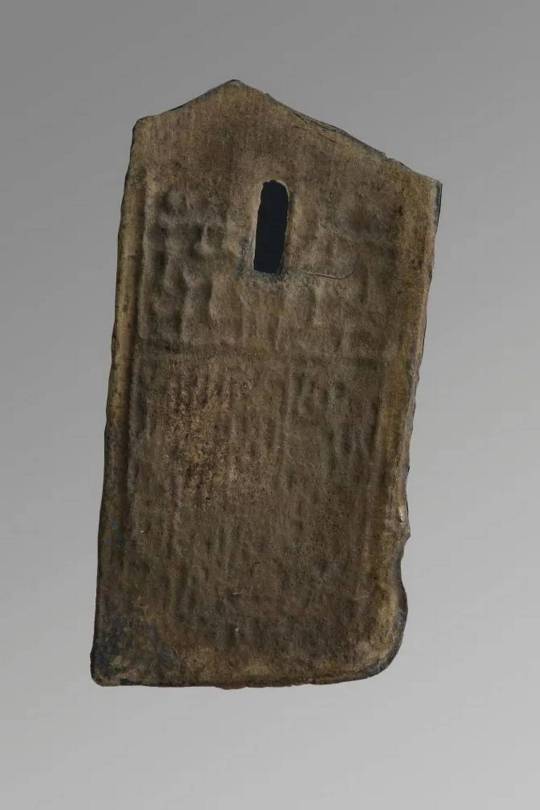
Experts also found pottery, porcelain, metalware, bamboo, wood artifacts, and plant and animal remains.
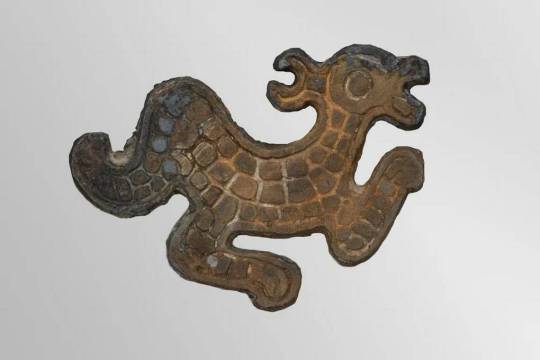
Among the animal remains, they found evidence of cattle, pigs, deer, fish and rare horses. There were also leftover grains and the remains of vegetables and fruits.
A LARGE CEREMONIAL BUILDING
At the Tingshan site, archaeologists found the ruins of what they believe was once a large ceremonial public building.
Experts unearthed part of the building’s foundation: an east-west wall spanning about 180 feet long and a north-south wall spanning about 30 feet wide.
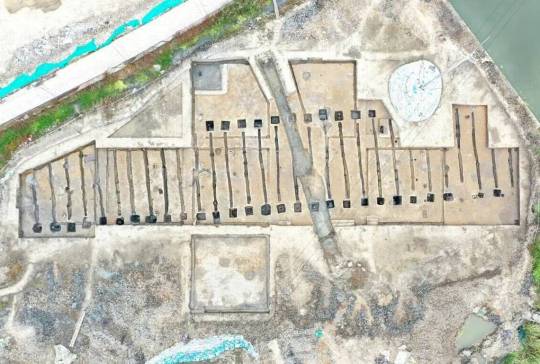
Whoever built the ancient structure likely dug the foundation’s trench and then placed a ground beam with attached columns into the trench, according to officials.

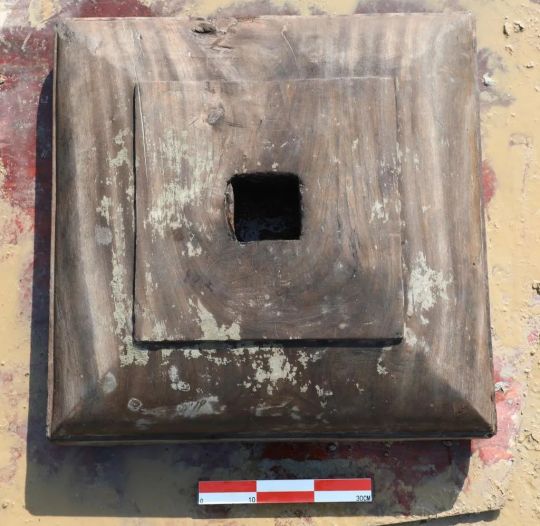
Archaeologists unearthed the building’s intricate column network, including exquisitely decorated and painted pillars.
AN ANCIENT WHARF AND SACRIFICIAL PIT
In another area of the Tingshan site, experts identified the ruins of an ancient wharf, known as the Linshui Wharf.
Archaeologists discovered three organized rows of wooden stakes left from the ancient dock-like structure.
They also found the remains of a sacrificial pit — still filled with offerings.
The pit held artifacts, including charcoal and food, according to officials.
Shaoxing is in the Zhejiang province in eastern China.
By MOIRA RITTER.
#2200-Year-Old Bronze Artifacts Uearthed in China#Shaoxing#Tingshan Nanshantou and Nanshan#Warring States era#Spring and Autumn Period#bronze#ancient artifacts#archeology#archeolgst#history#history news#ancient history#ancient culture#ancient civilizations#ancient china#chinese history#chinese art
34 notes
·
View notes
Photo

Shenzhen Genzon Technology Innovation Center In China
Aedas’ triumphant scheme of Genzon Technology Innovation Center in Shenzhen’s Nanshan District of China encompasses offices that promote a new mode of working, luxury hotel facilities, and a bracing shopping experience. The project will be an important node on “Silicon Valley Avenue” connecting key areas of Shenzhen’s high-tech industries.




#shenzhen genzon technology innovation center#china#aedas#architectural studio#shenzhen#nanshan district#architecture#silicon valley avenue#high-tech industries#future architecture
16 notes
·
View notes
Text

0 notes
Text
打鐵花 (da2tie3hua1; struck iron fireworks) is a traditional folk firework that began in Henan and Shanxi, first arising in Queshan county, Henan and later circulating through the whole country. It had first appeared during the Northern Song dynasty, and was most popular during the Ming and Qing dynasties.
For Queshan struck iron fireworks, a two-layer pergola is built and covered with willow branches for performances, under which the molten iron is struck up with two willow sticks to create a rain of fire.
[eng by me + edited an ad out]
(On top of the information in the video, I have some more about its recent history under the cut.)
*Also, a note about one of the subtitles: I realized later that "going into battle without a shield" actually just meant going shirtless. I was only confused about this phrasing while translating because she didn't go shirtless, although that is for obvious reasons
Queshan struck iron fireworks had almost been lost before Yang Jianjun unearthed it again in 1988. It had almost died out in the early years of the Republic of China being established, after which there had only been three performances until 1988: 1952, 1956, 1962. Yang Jianjun had seen the 1956 performance as a 7-8 year old and later on as the director of a cultural centre, began digging up the skill and its history. In the process, he became an apprentice to Li Wanfa, who had been the last head of the Queshan Struck Iron Fireworks Society. He practised with sand and water, learning of its historical origin, its ancestral inheritors, craftsmanship and performance arts, but didn't touch the real thing until 1988. Through Yang Jianjun's efforts and investment, the first struck iron fireworks performance in more than 25 years took place in Nanshan Square (then a deserted area) in Queshan county.
Queshan struck iron fireworks are different from other struck iron fireworks in that it requires a wide area to perform, whereas others only needed a wall or could be hit straight up into the air, and it costs much more money to set up.
The names of inheritors are difficult to trace, and can only be traced back to the Qing dynasty during the Qianlong period, making Yang Jianjun a sixth-generation inheritor, and Jiang Xunqian (OP) the first woman and a seventh-generation inheritor.
#douyin#arts#imparting culture#struck iron fireworks#creator: 江寻千(九月)#personal fav#i spent wayyyy too much time on this#def the most time i've ever spent on a post#i'm v v excited to post this#also i originally tl'd 打铁花 as blacksmith's fireworks and then i realised that wouldn't work
8K notes
·
View notes
Text
Nanshan Temple History

The Nanshan Temple is a new addition to Chinese history. It actually dates back to the late 1990s. Its history dates back over 2000 years. This temple is located on the beautiful seacoast. It has been called the Temple between the Sky and the Sea.
Nanshan Temple, a Buddhist complex, is located approximately 25 miles west of Sanya on the island of Hainan in southern China. Nanshan, which is Southern Mountain_, is one of three parks that make up the Nanshan Culture Tourism Zone. Other parks include the Hainan Custom Culture Park and Blessing and Longevity Park. China's most southern Buddhist shrine, Nanshan Temple, is located in China. It is known for its massive Buddha statue in gold and the statue of a Buddhist deity standing over 300 feet above the sea.
The History of the Nanshan Temple
Since the arrival of Buddhism to China, Hainan Island has been a significant place for Buddhism. This area is sacred and dedicated to Avalokitesvara. He is considered an incarnation Buddha in some traditions, and a Bodhisattva by others. Bodhisattva in Buddhism is someone who has attained a high level of knowledge, and enlightenment and seeks to help others.
Guan-Yin, also known as Avalokitesvara is often depicted as a female. Twelve wishes were granted to her during her lifetime, one of which was to live to close the South China Sea. Hainan, today, is considered a sacred site and the home of Avalokitesvara.
The Nanshan Temple was built in April 1998 to commemorate the 2000th anniversary of the arrival of Buddhism in China. The temple was quickly popularized by the rapid growth of the island's urban population and now receives many foreign and local visitors every year.
Read More... https://raahdekrishna.org/nanshan-temple-history
0 notes
Video
youtube
English translation for 红马 (女版) sung by 许蓝心
translation is by yours truly ;)
✧・゚: *✧・゚*:・゚✧*:・゚✧ - ✧・゚: *✧・゚:*
Red Horse
I’m in Jiangnan, sprinkling joy free from sin,
You used the setting sun and broke the spring snow,
You’re in Qingjian, rouge parasol, damask satin,
Your music sings prospering embroidered lakes and mountains,
.
Nanshan’s fishing village at night, a bowl of rice wine for three coins,
You travel the whole of Qingzhou province,
Riding a red horse, feet in cloud boots, searching for a soulmate
.
Woooh, by the clouds at dusk,
Woooh, sleeping to the sound of rain,
Woooh, love at west city
Woooh, parting at north city,
.
I’m in Jiangnan, spreading joy free from sin,
You used the setting sun and broke the spring snow,
You’re in Qingjian, rouge parasol, damask satin,
Your music sings prospering embroidered lakes and mountains,
.
Woooh, by the clouds at dusk,
Woooh, sleeping to the sound of rain,
Woooh, love at west city
Woooh, parting at north city,
.
I’m in Jiangnan, spreading joy free from sin,
You used the setting sun and broke the spring snow,
You’re in Qingjian, rouge parasol, damask satin,
Your music sings prospering embroidered lakes and mountains,
.
I’m in Jiangnan,
You use the setting sun,
You’re in Qingjian,
You play a song
.
#chinese translation#chinese media#gu feng music#douyin#douyin music#古风#红马#许蓝心#cpop#chinese viral pop
61 notes
·
View notes
Text
May you live as long as Mount Nanshan

#chinesepainting#chineseart#art#artist#illustration#artwork#fineart#artoftheday#inkpainting#painting
21 notes
·
View notes
Text

Shenzhen Bay Park, Nanshan, Shenzhen, Guangdong Province, China
Taken by Cai Fang
0 notes
Text
The Mirung
A Deinocheirus is in this one.
(From the travel journal of Janusz Kansk)
I know we’re in trouble when everyone goes quiet. I turn to my traveling companion and ask her what’s going on.
“We’re entering gullah territory,” she tells me, and I understand. Gullahs are notoriously territorial and ill-tempered, so it isn’t surprising that our Iwak guides wouldn’t want to attract their attention. At nine meters long and weighing over five tons, our canoe wouldn’t be much more than a speed bump to one.
We row on in silence. Luckily the sun is up, and we can see around us. I wouldn’t want to pass through gullah territory in the dark. The reeds grow tall and thick on either side of us, and every time we hear something move within we hold our breath. At one point we hear the sharp, booming GULLAH! GULLAH! call that gives the iquanodont its name, but thankfully nothing comes charging out at us. Eventually our Iwak friends begin talking again, and I know we’re through the gauntlet.
I’m in Tam’s Laistun Province, traveling up the Nanshan River with Egato Leng. Egato is a conservationist working in the provincial capital of Phonguoket, and she’s made it her life’s mission to get Deinocheirus, known locally as the mirung, off the International List of Threatened Species. If I hadn’t been on board with her goal when I began this adventure, I certainly would have been converted along the way. Egato is a petite, skinny woman in her mid-thirties, with crinkly golden-brown skin, an infectious smile, and a crackling natural energy. She almost feels like a melding of two disparate worlds, with her traditional helmet-shaped Hamur headdress festooned with metal discs and baubles clashing with her thoroughly modern t-shirts and jeans. She’d attended college at Amsant’s University of New Morris and speaks more or less fluent Andrish, which is fortunate since I don’t speak a word of any of the half-dozen dialects used in this region.
Egato’s enthusiasm for what she does practically pours off her. I honestly don’t think the woman is capable of talking about mirungs without getting a big goofy grin on her face, and I usually can’t help getting one myself soon after. She never just talks; she has to animate, enhancing every conversation with wild gesticulations that sometimes border on flailing. After the three days spent getting to know this woman as we navigated the sludgy rivers of mud that pass for roads in Laistun and canoed up the Nanshan I feel like I’ve been brainwashed into loving mirungs nearly as much as she does. I couldn’t wait until we got to the Gon marshlands and I’d have a chance to see one in the flesh.
I pass the time by taking pictures. I shoot our Iwak guides and they flex and pose for the camera, throwing Diojin street gang signs that they almost certainly haven’t earned the right to use. I turn around to shoot Egato and she giggles and covers her face.
We pass through a mangrove forest, where the branches are so low and the water so shallow that Egato and I have to lie on our backs while our guides get out and shove us through. On either side of us the mud is dotted by dark fiddler crabs, waving their brightly colored claws at us and each other. The display brings to my mind the gang signs our guides were flashing earlier, and I can’t help but laugh. Then an armored cricket the size of a small potato drops onto me and refuses to let go of my shirt when I try to sweep it off, and everyone else laughs.
As the trees open up one guide wades on ahead to check for any further obstacles, and a few minutes later we hear him shout back to us in Iwaki. I’m asking what he said right as several big fish come down the stream at us, leaping through the shallow water. Egato shouts as one of the fish jumps right into the canoe, flopping and banging around in an attempt to get back to the water. We both pull our feet in as the other guide falls on it with a knife, stabbing it several times before holding it up triumphantly. He grins and says something, and when the laughter subsides and we can all breathe again Egato translates: “Dinner!”
Finally we leave the mangroves, and we’re in the Gon. The broad marsh spreads out around us, dotted by aquatic grasses, bulrushes, and cypress trees. Long-tailed dactyls swoop and dip over the water, coming up with little fish snared in their snaggletoothed jaws, and a smooth-scaled, gharial-looking champsosaur with a head like a long-handled frying pan slides off a half-submerged tree into the water as we pass by. Almost immediately we’re surrounded by little blue damselflies. The sun is shining, birds are singing in the trees, and I feel like if I burst into song right here I’d be surrounded by dancing cartoon animals by the end of the first verse.
Both guides are back in the boat now, citing fears of crocodiles. Probably wise, given what I know of these ecosystems. While we don’t see any crocodiles, we do come upon an impressively sized baryonychine. It’s sitting on the bank of a low island, and as we pass alongside it gets up and heads further away from the water.
And then, finally, we see what we’d come all the way out here for: a mirung. We come around a stand of cypress trees and there it is, lumbering through the water in all its shaggy, long-necked, long-armed, hump-backed glory. It really is kind of a ridiculous-looking animal, with its bright red and yellow head, shaggy gray-brown feathers, and weird posture and proportions. The impression I get is of a fat kid laboring under the weight of a heavy backpack, who got his neck caught in a taffy puller. I don’t dare say that to Egato, though.
I look over at her, and of course she’s grinning from ear to ear. Our guides stop rowing and let us coast towards the giant animal, and it just watches us approach with a dumb sort of look on its face. I’m reminded here that mirungs are essentially huge, odd-looking ornithomimosaurs that gave up running, and it definitely looks the part. Ornithomimes were never known for their intelligence.
Amazingly, the mirung doesn’t budge even as we come up alongside it, and in fact it even comes over to investigate us. The guides and I instinctively lean away from that massive beaked head as it dips down to sniff us, but Egato is braver than we are. She looks like she’s about to cry as the animal’s breath ruffles her shirt, and she even reaches up and strokes its snout as I photograph the encounter.
Eventually the mirung has its fill of us and moves on, and the guides and I share satisfied glances. Such a close encounter was much better than anything I’d come down here hoping to get, and I’m very happy. Egato, meanwhile, looks like she’s just had a religious experience, complete with tears running down her face. I’m pretty sure I just photographed the single greatest experience of her life.
#dinopunk#writing#my writing#fantasy writing#fiction#short stories#deinocheirus#lurdusaurus#suchomimus#champsosaurus#dinosaurs#short fiction
2 notes
·
View notes
Text


i was anticipating the absolute comedy of this scene ever since it appeared in the trailers but, in another demo of my terrible facial recognition, i only now realize it's the Gang (well half the Gang plus some others. i blame them for throwing me off)
anyway this is still so good. the utter 😬. wang kuan with the brush in his mouth. wei yanei with teeth of steel apparently holding that sack of silver. lu nanshan being totally unmoved when the thing falls over like why am i stuck here with these stupid kids. chicken dad taking a nap in the corner.
this whole arc is just like the nine of them ganging up on one clueless guy, truly incredible
#young blood#synco talks#and all the xincheng jokes ofc#'look into my honest eyes' shit right here#i know they def did a 'zang' xincheng joke last season but it's so funny they can do it again#i feel like last time it was more undercover#zhang xincheng actually starting to cry LOL
1 note
·
View note
Text
The Future Of Push-To-Talk Over Cellular Communication
PTToC stands for push to talk over cellular, which is the future of communication. The Wi-Fi network radios are key to unlocking its complete potential. With its little price, sophisticated features, and top level of security, push-to-talk over cellular is an ultimate communication solution for the businesses of all sizes. Whether you are searching to enhance efficiency, improve business operations, or just stay connected with your employees, PTToC is the way ahead. In addition to, PTToC is extremely safe with encryption and verification protocols in rest to make sure that the communication is highly secret and concealed. This is particularly significant for the businesses that agreement with susceptible information or work in extremely synchronized industries.
How PTToC is Transfiguring Communication With Wi-Fi Network Radios?
PTToC is a pioneering communication technology that permits dual way radio communication. It merges the handiness and effortlessness of customary two-way radio systems with the flexibility and scalability of cellular networks. With PTToC, the businesses can converse instantaneously and competently with their workers, in spite of their location.
The wifi network radio is becoming gradually more admired in the world of PTToC. They permit for communication over both cellular networks and Wi-Fi networks, and making them a flexible and consistent choice for businesses. It can also be used in areas, where the cellular coverage is underprivileged, and guaranteeing that the communication is always possible.
One of the chief benefits of PTToC is its small cost. Unlike the conventional two-way radio systems that need luxurious infrastructure and equipment, PTToC needs only a smartphone or tablet and a reliable internet connection. This makes it an easy to get to option for the businesses of all sizes.
For more information about our network radios, amateur radios, PoC, LTE radios, visit our website: https://boxchiptt.com
Our Contact Address:
Room 305, Building A, Huahan Technology, No. 16 Langshan Road, Nanshan District, Shenzhen, China - 518057
Phone: +86 13923773242
Email: [email protected]
Washington, District of Columbia, USA - 20006
4 notes
·
View notes
